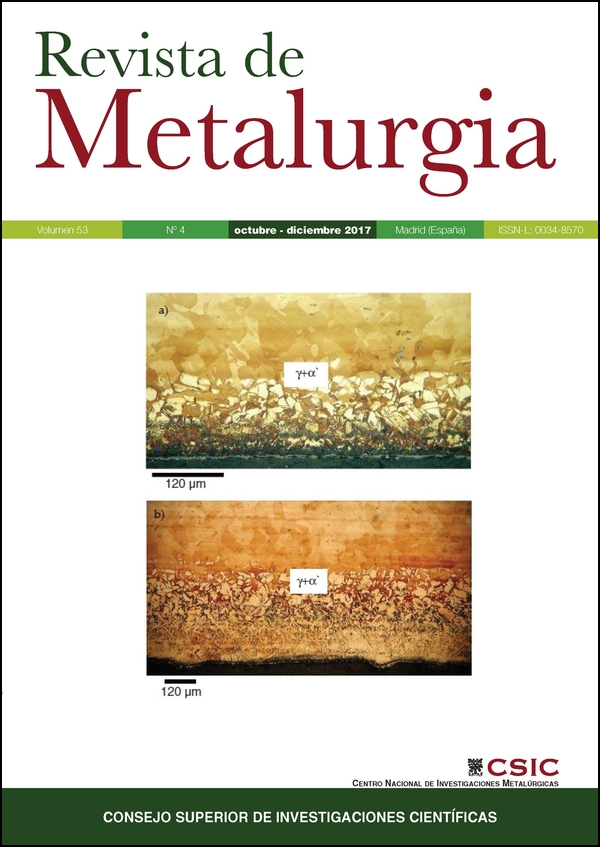Evaluation of Electrochemical Behavior of Nopal Extract (Opuntia Ficus- Indica) as Possible Corrosion Inhibitor
DOI:
https://doi.org/10.3989/revmetalm.108Keywords:
Corrosion inhibitor, Electrochemical impedance spectroscopy, Nopal extract, Polarization resistanceAbstract
Corrosion is one of the main problems of degradation in components, tooling, equipment and even in structural applications, examples of this are the carbon steels. In the present work, the capacity of corrosion inhibition of a biodegradable organic extract from the Nopal plant (Opuntia ficus-indica), for the protection of carbon steel type AISI 1018 was studied adding 50% v/v of the Nopal extract (EN) in a solution of H2SO4 (0.6 mol.l-1). Polarization Resistance (LPR) and Electrochemical Impedance Spectroscopy (EIS) techniques were used for the electrochemical evaluation at room temperature for 24 h in order to obtain corrosion rates (Vcorr) and inhibition efficiency (IE). Metallographic examination was also carried out to register the surface damage by corrosion. The results showed a reduction of the Vcorr with a maximum IE value of about 84% by adding the organic- liquid extracted from Nopal.
Downloads
References
Abreu-Quijano, M., Palomar-Pardavé, M., Cuán, A., Romero-Romo, M., Negrón-Silva, G., Álvarez-Bustamante, R., Ramírez-López, A., Herrera-Hernández, H. (2011). Quantum chemical study of 2-mercaptoimidazole, 2-Mercaptobenzimidazole, 2-Mercapto-5-Methylbenzimidazole and 2-Mercapto-5-Nitrobenzimidazole as corrosion inhibitors for steel. Int. J. Electrochem. Sci. 6 (9), 3729–3742. http://www.electrochemsci.org/papers/vol6/6093729.pdf.
Espinoza-Vázquez, A., Negrón-Silva, G.E., González-Olvera, R., Angeles-Beltrán, D., Herrera-Hernández, H., Romero-Romo, M., Palomar-Pardavé, M. (2014). Mild steel corrosion inhibition in HCl by di-alkyl and di-1,2,3-triazole derivatives of uracil and thymine. Mater. Chem. Phys. 145 (3), 407–417. https://doi.org/10.1016/j.matchemphys.2014.02.029
Flores de los Ríos, J.P., Sánchez-Carrillo, M., Nava-Dino, C.G., Chacón-Nava, J.G., González-Rodríguez, J.G., Huape-Padilla, E., Neri-Flores, M.A., Martínez-Villafa-e, A. (2015). Opuntia Ficus-Indica Extract as Green Corrosion Inhibithor for Carbon Steel in 1M HCl Solution. J. Spectrosc. 2015, ID 714692.
Garfias-García, E., Colin-Paniagua, F.A., Herrera-Hernández, H., Juarez-Garcia, J.M., Palomar-Padavé, M., Romero-Romo, M. (2010). Electrochemical and microscopy study of localized corrosion on a sensitized stainless steel AISI 304. ECS Transactions 29 (1), 93–102. https://doi.org/10.1149/1.3532307
Gopiraman, M., Sakunthala, P., Kesavan, D., Alexramani, V., Kim, I.S., Sulochana, N. (2011). An investigation of mild carbon steel corrosion inhibition in hydrochloric acid medium by environment friendly green inhibitors. J. Coat. Technol. Res. 9 (1), 15–26. https://doi.org/10.1007/s11998-011-9374-6
Herrera-Hernández, H., Franco-Tronco, M.I., Miranda-Hernández, J.G., Hernández-Sánchez, E., Espinoiza-Vázquez, A., Fajardol, G. (2015). Gel de Aloe-Vera como Potencial Inhibidor de la Corrosión del Acero de Refuerzo Estructural. Avances en Ciencias e Ingeniería 6 (3), 9–23. http://www.redalyc.org/articulo.oa?id=323642274002.
Ibrahim, T.H., Chehade, Y., Zour, M.A. (2011). Corrosion inhibition of mild steel using potato peel extract in 2M HCL solution. Int. J. Electrochem. Sci. 6, 6542–6555. http://www.electrochemsci.org/papers/vol6/6126542.pdf.
Ibrahim, T.H., Zour, M.A. (2011). Corrosion Inhibition of Mild Steel using Fig Leaves Extract in Hydrochloric Acid Solution. Int. J. Electrochem. Sci. 6, 6442–6455. http://www.electrochemsci.org/papers/vol6/6126442.pdf.
Ismail, M., Raja, B., Salawu, A.A. (2015). Developing Deeper Understanding of Green Inhibitors for Corrosion of Reinforcing Steel in Concrete. Chapter 7, In: Handbook of Research on Recent Development in Materials Science and Corrosion Engineering Education. Ed. Hwee, L.L. USA, pp. 118–123. https://doi.org/10.4018/978-1-4666-8183-5.ch007
Khaled, K.F. (2010). Experimental, density function theory calculations and molecular dynamics simulations to investigate the adsorption of some thiourea derivatives on iron surface in nitric acid solutions. Appl. Surf. Sci. 256 (22), 6753–6763. https://doi.org/10.1016/j.apsusc.2010.04.085
Palomar-Pardavé, M., Romero-Romo, M., Herrera-Hernández, H., Abreu-Quijano, M.A., Likhanova, N.V., Uruchurtu, J., Juárez-García, J.M. (2012). Influence of the alkyl chain length of 2amino 5 alkyl 1,3,4 thidiazole compounds on the corrosion inhibition of steel immersed in sulfuric acid solutions. Corros. Sci. 54, 231–243. https://doi.org/10.1016/j.corsci.2011.09.020
Sanyal, B. (1981). Organic compounds as corrosion inhibitors in different environments-A review. Prog. Org. Coat. 9 (2), 165–236. https://doi.org/10.1016/0033-0655(81)80009-X
Singh, W.P., Bockris, J.O. (1996). Toxicity issues of organic corrosion inhibitors; applications of QSAR Model. Proceeding Corrosion 96, NACE International, Houston, USA.
Torres-Acosta, A.A., Martínez-Molina, W., Alonso-Guzmán, E.M. (2012). State of the Art on Cactus Additions in AlkalineMedia as Corrosion Inhibitors. Int. J. Corr. 2012, ID 646142. PMCid:PMC3428005
Published
How to Cite
Issue
Section
License
Copyright (c) 2017 Consejo Superior de Investigaciones Científicas (CSIC)

This work is licensed under a Creative Commons Attribution 4.0 International License.
© CSIC. Manuscripts published in both the printed and online versions of this Journal are the property of Consejo Superior de Investigaciones Científicas, and quoting this source is a requirement for any partial or full reproduction.
All contents of this electronic edition, except where otherwise noted, are distributed under a “Creative Commons Attribution 4.0 International” (CC BY 4.0) License. You may read the basic information and the legal text of the license. The indication of the CC BY 4.0 License must be expressly stated in this way when necessary.
Self-archiving in repositories, personal webpages or similar, of any version other than the published by the Editor, is not allowed.
















